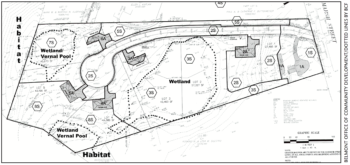Photo: The proposed entry to the Sleepy Hollow Road.
Sleepy Hollow Road, a controversial new cul-de-sac connecting Marsh Street to five proposed “McMansions” on the land of a well-known Boston developer, will make like Ichabod Crane and nod off before waking up sometime next year, according to Glenn Clancy, director of the Office of Community Development.
A hearing before the Board of Survey – made up of the three-member Board of Selectmen – to review the suggested road snaking through the rear of Donald Chafaro’s nearly seven-acre property at 178 Marsh, was withdrawn “without prejudice” by the applicant at the Monday night meeting, Oct. 24.
But the removal of the application does not mean the residential subdivision that will encroach onto protected wetlands and the Massachusetts Audubon’s Habitat Education Center and Wildlife Sanctuary is going away for good. Since no formal action was taken by the Board of Survey, Chafaro can bring the application “at another time in the future,” said Clancy.
According to Clancy, the withdrawal of plans to create six housing parcels along nearly 200-foot roadway was due to a misreading of the town’s regulations rather than a change of mind.
“There was a misunderstanding with the engineer who is leading the project. He was under the impression that any environmental review [of the road] would be the last step of the process [after a Board of Survey decision,]” Clancy told the Board.
While there are communities around Belmont where the final step in the regulatory process is a review, “our Board of Survey rules and regulations makes it very clear that the environmental [assessment] must be done before the Board will consider an application,” said Clancy.
It is now up to the state to determine which town agency will conduct the evaluation.
Mary Trudeau, the town’s conservation agent, has requested the state’s Department of Environmental Protection for a determination of the jurisdiction of the Wetlands Protection Act. If the DEP allows the town to review the environmental concerns, the probe will be conducted by the OCD’s engineering staff. Otherwise, the project will fall under a Conservation Commission review.
Clancy said if the state selects the Conservation Commission route, “then the applicant must make a formal application” which could take “a couple or more months.”
The news came as “a small moral victory” for opponents of the development, according to Roger Wrubel, director of Habitat Sanctuary for the past 16 years. Wrubel and others contend the development will result in further loss of open space as other landowners with large lots take advantage of spiraling housing prices.









Leave a Review or Comment